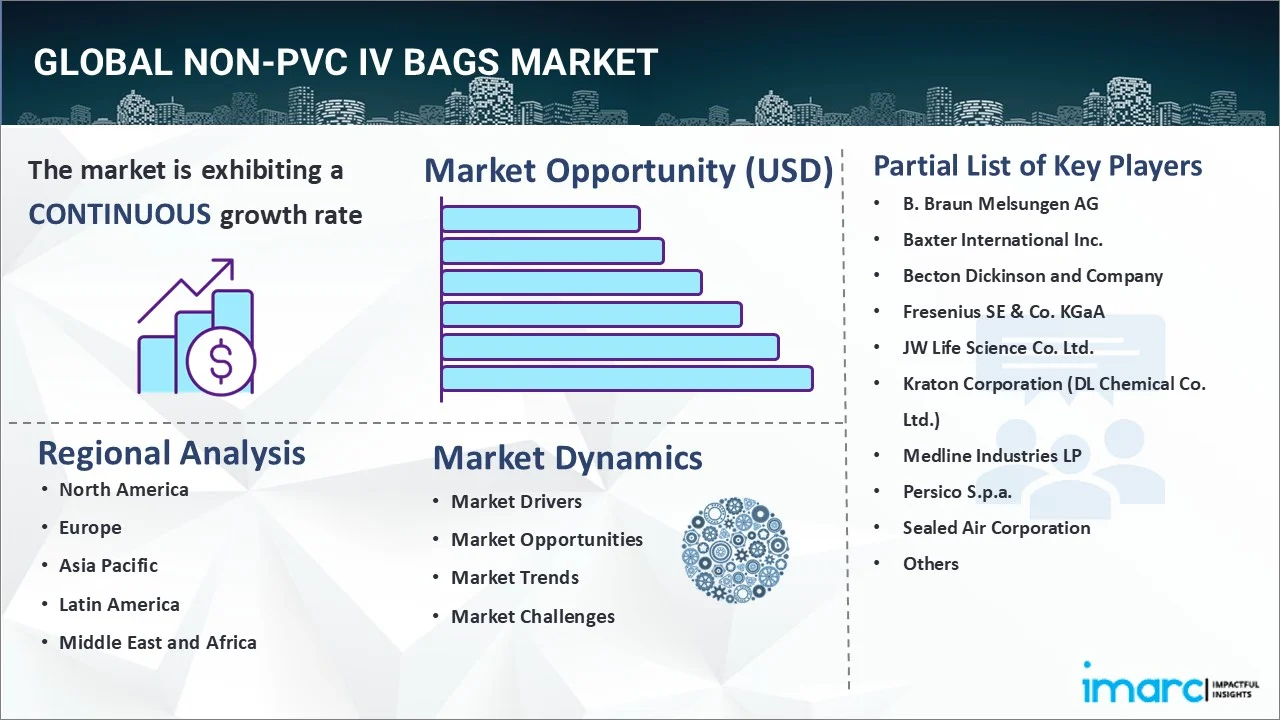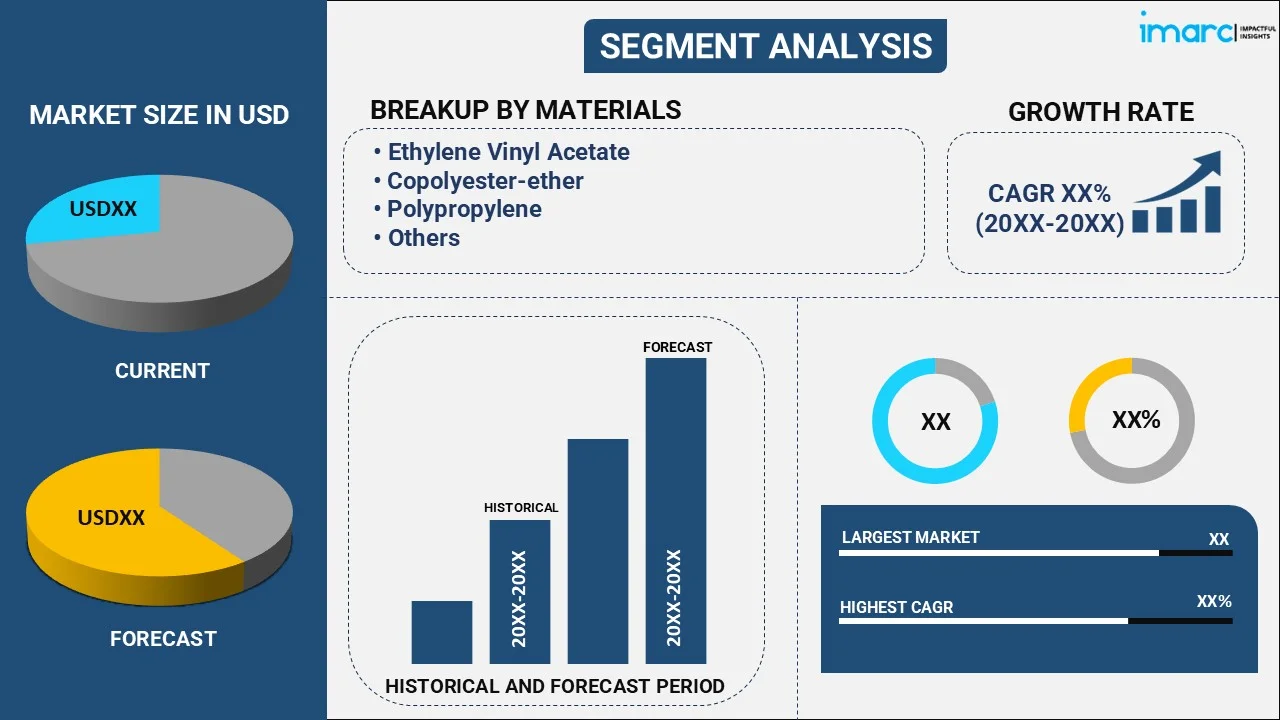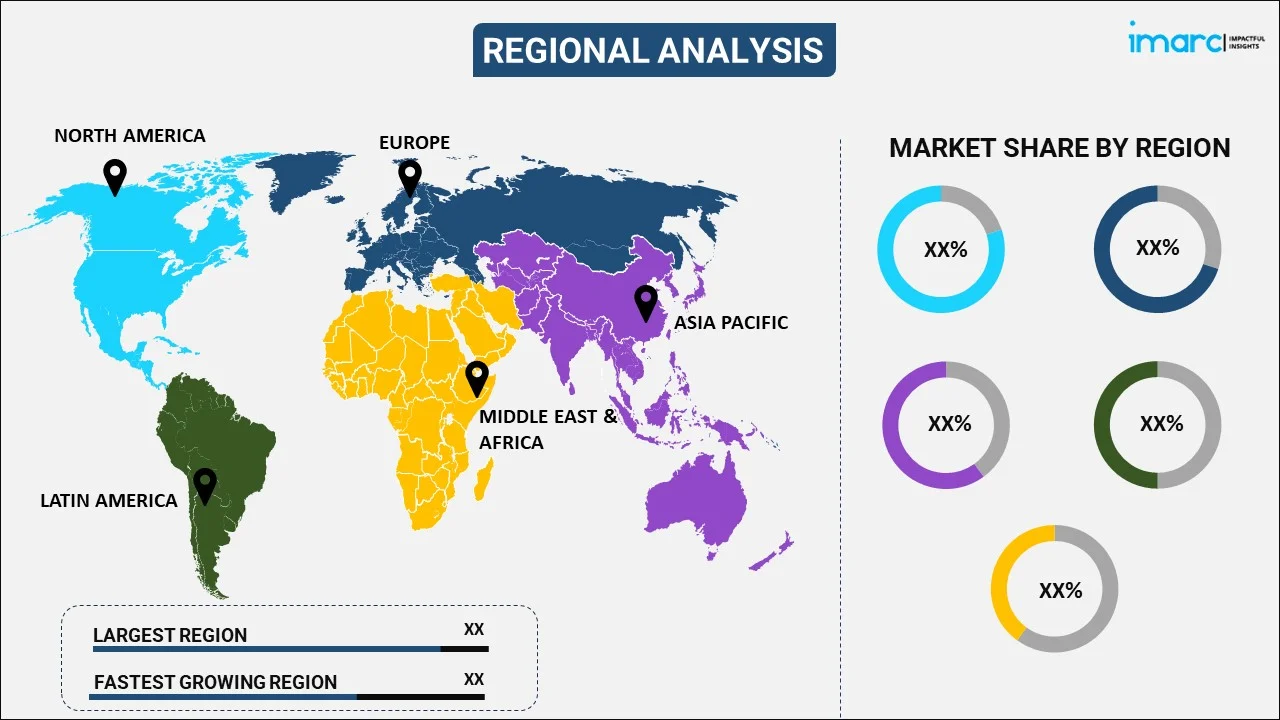
Non-PVC IV Bags Market Report by Material (Ethylene Vinyl Acetate, Copolyester-ether, Polypropylene, and Others), Product (Multi Chamber, Single Chamber), Content (Frozen Mixture, Liquid Mixture), Application (Chemotherapy, Targeted Drug Delivery, Glucose Injection, Sodium Chloride Solution, Electrolyte Injection, Nutrient Injection, and Others), End User (Hospitals, Clinics, Emergency Service Centers, Ambulatory Surgical Centers, and Others), and Region 2025-2033
Market Overview:
The global non-PVC IV bags market size reached USD 1.9 Billion in 2024. Looking forward, IMARC Group expects the market to reach USD 3.3 Billion by 2033, exhibiting a growth rate (CAGR) of 5.8% during 2025-2033.
|
Report Attribute
|
Key Statistics
|
|---|---|
|
Base Year
|
2024
|
|
Forecast Years
|
2025-2033
|
|
Historical Years
|
2019-2024
|
|
Market Size in 2024
|
USD 1.9 Billion |
|
Market Forecast in 2033
|
USD 3.3 Billion |
| Market Growth Rate 2025-2033 | 5.8% |
Non-polyvinyl chloride (non-PVC) intravenous (IV) bags are manufactured using polypropylene, polyethylene, copolyester-ether, and ethylene-vinyl acetate films. They are specifically designed for packaging rehydration solutions and storing certain antibiotics and analgesics for hospital and veterinary usage. Moreover, they can be extensively utilized in cold storage without inhibiting the quality and shelf-life of the stored items. Unlike PVC IV bags that often face drug and container interaction problems, these bags provide improved safety, lowered risks of contamination and enhanced convenience of usage. As a result, non-PVC IV bags find extensive applications in parenteral nutrition, oncology, chemotherapy, and targeted drug deliveries.

Non-PVC IV Bags Market Trends:
The market is primarily driven by the rising incidences of hospital-acquired infections (HAIs) among the masses. Coupled with the increasing influx of patients requiring intravenous antibiotics across healthcare facilities, this has provided a boost to the uptake of non-PVC IV bags. Also, the widespread adoption of single-chambered non-PVC IV bags in IV drips and other mixtures due to their convenience of management, transportation, and disposal is significantly contributing to the product sales. In addition to this, the growing number of point-of-care (POC) facilities across the globe and the preference for home care setups, especially for the geriatric population, are favorably impacting the market growth. The market is further driven by the escalating popularity of IV bags made up of ethylene-vinyl acetate (EVA). Since these bags offer excellent adhesion to non-porous substrates at an affordable price point, they are widely utilized by healthcare professionals on the global level. Some of the other factors creating a positive outlook for the market include the augmenting demand for biologically inert medical supplies, considerable developments in the healthcare infrastructure and extensive research and development (R&D) activities.
Key Market Segmentation:
IMARC Group provides an analysis of the key trends in each sub-segment of the global non-PVC IV bags market report, along with forecasts at the global, regional and country level from 2025-2033. Our report has categorized the market based on material, product, content, application and end user.
Breakup by Material:

- Ethylene Vinyl Acetate
- Copolyester-ether
- Polypropylene
- Others
Breakup by Product:
- Multi Chamber
- Single Chamber
Breakup by Content:
- Frozen Mixture
- Liquid Mixture
Breakup by Application:
- Chemotherapy
- Targeted Drug Delivery
- Glucose Injection
- Sodium Chloride Solution
- Electrolyte Injection
- Nutrient Injection
- Others
Breakup by End User:
- Hospitals
- Clinics
- Emergency Service Centers
- Ambulatory Surgical Centers
- Others
Breakup by Region:

- North America
- United States
- Canada
- Asia-Pacific
- China
- Japan
- India
- South Korea
- Australia
- Indonesia
- Others
- Europe
- Germany
- France
- United Kingdom
- Italy
- Spain
- Russia
- Others
- Latin America
- Brazil
- Mexico
- Others
- Middle East and Africa
Competitive Landscape:
The competitive landscape of the industry has also been examined along with the profiles of the key players being B. Braun Melsungen AG, Baxter International Inc., Becton Dickinson and Company, Fresenius SE & Co. KGaA, JW Life Science Co. Ltd., Kraton Corporation (DL Chemical Co. Ltd.), Medline Industries LP, Persico S.p.a., Sealed Air Corporation and Sippex IV bags.
Report Coverage:
| Report Features | Details |
|---|---|
| Base Year of the Analysis | 2024 |
| Historical Period | 2019-2024 |
| Forecast Period | 2025-2033 |
| Units | Billion USD |
| Segment Coverage | Material, Product, Content, Application, End User, Region |
| Region Covered | Asia Pacific, Europe, North America, Latin America, Middle East and Africa |
| Countries Covered | United States, Canada, Germany, France, United Kingdom, Italy, Spain, Russia, China, Japan, India, South Korea, Australia, Indonesia, Brazil, Mexico |
| Companies Covered | B. Braun Melsungen AG, Baxter International Inc., Becton Dickinson and Company, Fresenius SE & Co. KGaA, JW Life Science Co. Ltd., Kraton Corporation (DL Chemical Co. Ltd.), Medline Industries LP, Persico S.p.a., Sealed Air Corporation, Sippex IV bags |
| Customization Scope | 10% Free Customization |
| Post-Sale Analyst Support | 10-12 Weeks |
| Delivery Format | PDF and Excel through Email (We can also provide the editable version of the report in PPT/Word format on special request) |
Key Questions Answered in This Report
The global non-PVC IV bags market was valued at USD 1.9 Billion in 2024.
We expect the global non-PVC IV bags market to exhibit a CAGR of 5.8% during 2025-2033.
The increasing incidences of Hospital-Acquired Infections (HAIs) and the rising awareness towards the utilization of non-PVC IV bags, such as improved safety, lowered risks of contamination, and enhanced convenience of usage, are primarily driving the global non-PVC IV bags market.
The sudden outbreak of the COVID-19 pandemic has led to the escalating demand for non-PVC IV bags for storing the coronavirus vaccines in a cold storage without inhibiting the quality and its shelf-life.
Based on the material, the global non-PVC IV bags market has been segmented into ethylene vinyl acetate, copolyester-ether, polypropylene, and others. Currently, ethylene vinyl acetate holds the majority of the total market share.
Based on the product, the global non-PVC IV bags market can be divided into multi chamber and single chamber, where single chamber currently exhibits a clear dominance in the market.
Based on the content, the global non-PVC IV bags market has been categorized into frozen mixture and liquid mixture. Currently, liquid mixture accounts for the majority of the global market share.
Based on the end user, the global non-PVC IV bags market can be segregated into hospitals, clinics, emergency service centers, ambulatory surgical centers, and others. Among these, hospitals hold the largest market share.
On a regional level, the market has been classified into North America, Asia-Pacific, Europe, Latin America, and Middle East and Africa, where North America currently dominates the global market.
Some of the major players in the global non-PVC IV bags market include B. Braun Melsungen AG, Baxter International Inc., Becton Dickinson and Company, Fresenius SE & Co. KGaA, JW Life Science Co. Ltd., Kraton Corporation (DL Chemical Co. Ltd.), Medline Industries LP, Persico S.p.a., Sealed Air Corporation, and Sippex IV bags.
Need more help?
- Speak to our experienced analysts for insights on the current market scenarios.
- Include additional segments and countries to customize the report as per your requirement.
- Gain an unparalleled competitive advantage in your domain by understanding how to utilize the report and positively impacting your operations and revenue.
- For further assistance, please connect with our analysts.
 Request Customization
Request Customization
 Speak to an Analyst
Speak to an Analyst
 Request Brochure
Request Brochure
 Inquire Before Buying
Inquire Before Buying




.webp)




.webp)












